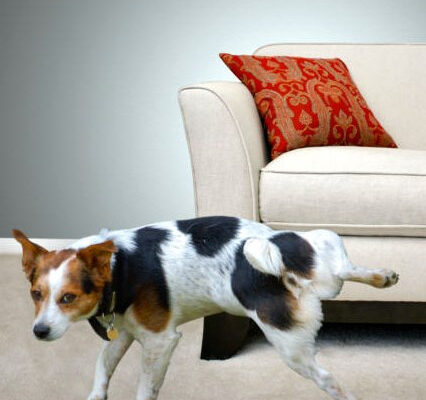House Soiling Or Urine-Marking? How To Tell The Difference!
Your pet may be urine-marking if:
- The problem is primarily urination. Dogs and cats rarely mark with feces.
- The amount of urine is small and is found primarily on vertical surfaces. Dogs and cats do sometimes mark on horizontal surfaces. Leg-lifting and spraying are common versions of urine-marking, but even if your pet doesn’t assume these postures, he may still be urine-marking.
- Any pet in your home is not spayed or neutered. Both intact males and females are more likely to urine-mark than are spayed or neutered animals. However, even spayed or neutered animals may mark in response to other intact animals in the home.
- Your pet urinates on new objects in the environment (a shopping bag, a visitor’s purse), on objects that have unfamiliar smells, or on objects that have another animal’s scent.
- Your pet has conflicts with other animals in your home. If one cat is intimidating another cat, the bullied cat may express his anxiety by urine-marking.
- Your pet has contact with other animals outside your home. A cat that’s allowed outdoors may come home and mark after having an encounter with another cat outside. If your pet sees another animal through a door or window, he may feel a need to mark his territory.
- Your dog marks frequently on neighborhood walks.
What You Can Do
- Spay or neuter your pet as soon as possible. Spaying or neutering your pet may stop urine-marking altogether; however, if he has been urine-marking over a long period of time, a pattern may already be established.
- Resolve conflicts between animals in your home. Call our behavior helpline or consult with a qualified behavior consultant for help, especially if there are also fights occurring.
- Restrict your pet’s access to doors and windows through which they can observe animals outside. If this isn’t possible, discourage the presence of other animals near your house.
- Keep your cat indoors. He’ll be safer, will live longer, and will feel less need to mark his territory.
- Clean soiled areas thoroughly with an enzymatic cleaner designed for pet soiling. Don’t use strong smelling cleaners as these may cause your pet to “overmark” the spot.
- Make previously soiled areas inaccessible or unattractive.
- If making soiled areas inaccessible or unattractive isn’t possible, try to change the significance of those areas. Feed, treat and play with your pet in the areas he is inclined to mark.
- Keep objects likely to cause marking out of reach. Guests’ belongings, new purchases and so forth, should be placed in a closet or cabinet.
- If your pet is marking in response to a new resident in your home (a new baby, roommate or spouse), have the new resident make friends with your pet by feeding, grooming and playing with your pet. Make sure good things happen to your pet when the new baby is around (see “Dog Meets Baby” and “Introducing Cats to Children“).
- For dogs: watch your dog at all times when he is indoors for signs that he is thinking about urinating. When he begins to urinate, calmly interrupt him and take him outside, then praise him and give him a treat if he urinates outside. When you’re unable to watch him, put your dog in confinement (a crate or small room where he has never marked) or tether him to you with a leash.
- For cats: use a product such as Feliway in areas where the cat has previously marked. These products contain relaxing pheromones that help cats feel calmer, and therefore less likely to mark.
What Not To Do
Don’t punish your pet after the fact. Punishment administered even a minute after the event is ineffective because your pet won’t understand why he is being punished.
Pets Aren’t People
Dogs and cats don’t urinate or defecate out of spite or jealousy. If your dog urinates on your baby’s diaper bag, it’s not because he is jealous of, or dislikes your baby. Likewise, if your cat urinates on your new boyfriend’s backpack, this is not his opinion of your taste in men.
Is it Anxiety?
Some pets may mark when they feel anxious or upset. For example, a new baby in the home brings new sounds, smells and people, as well as changes in routine. Your dog or cat probably isn’t getting as much attention as he was used to getting. All of these changes cause him to feel anxious, which may cause him to mark. Likewise, a pet who is generally anxious may become more so by the presence of roaming neighborhood animals in your yard, or by the introduction of a new cat or dog into your household. If your pet is feeling anxious, you might consider talking to your veterinarian about medications to reduce his anxiety while you work on behavior modification.








